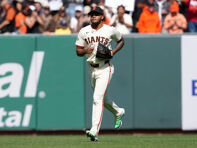Welcome back to Talkin’ Gaysball where it’s a natural fact when Jackie comes to bat, the other team is through.
The first artifact I saw upon walking into the Jackie Robinson Museum was his 1955 World Series ring.
Directly below were photos of Robinson and his family at the March on Washington. Next to it was a handwritten speech explaining in painstaking detail why he felt bitterness about America after decades of fighting for racial justice and seeing glacial progress.
It was a fitting introduction for how the museum managed to properly tell the story of one of the most impactful people in sports and American history. Furthermore, the display summarized why it’s a must-visit — not just for baseball fans but anyone interested in the potential for athletes to use their platform to advocate for societal change.
Get off the sidelines and into the game
Our weekly newsletter is packed with everything from locker room chatter to pressing LGBTQ sports issues.
Located in New York City’s Tribeca neighborhood, the Jackie Robinson Museum isn’t very big. But its rooms contain a density of displays, timelines and artifacts worthy of such a monumental figure.
Related


LGBTQ ally Liam Hendriks continues to be an All Star human as he continues rehab
Even facing a long road back to game action, Hendriks is a credit to baseball. Plus: Thirst Trap of the Week pays tribute to an all time great.
By Ken Schultz | May 3, 2024

San Francisco Giants’ Camilo Doval unveils a closer entrance worthy of the ‘Drag Race’ crown
The best closers in MLB turn a ballpark into a dance club.Plus: Joey Votto’s Swiftie cred and Thirst Trap of the Week.
By Ken Schultz | April 26, 2024
The most noteworthy choice that its curators made was to tell the story of Robinson’s life as a civil rights advocate before getting to the section about his baseball career.
Between his political activism, investments in affordable housing, and work for equal employment opportunities for the Black community, the focus of Robinson’s life was to use the fame baseball brought him to spend every second making the world a better place. Above all else, the museum is about amplifying this aspect of who he was.
When you take in the breadth of his tireless advocacy through these displays, it becomes clear that he was possessed of a special kind of courage. Most everyone knows about the bravery it took to reintegrate baseball in 1947 and the racial abuse he endured while keeping his promise to turn the other cheek when confronted by systemic racism for the first two years of his Dodgers career.
But after he had established himself and began speaking out against injustice, Robinson called upon an entirely different kind of courage. From that moment on, he was creating an entirely new template as a Black athlete activist. There were no models for what he was doing in the sports world.
During this time as he spoke out more frequently and his words carried greater influence, he could only rely on the love of his family and the courage of his convictions to find support in a hostile world.
As the museum makes abundantly clear, sometimes that struggle came close to breaking him. But it never stopped him or his belief in the righteousness of his fight.
While absorbing all of these parts of Robinson’s extraordinary life and seeing the colossal price he paid in his fight against bigotry, you also get a better understanding of why it’s essential to uplift the LGBTQ athletes who use their platform to speak up for our community today.
It’s why we laud Carl Nassib for his work with the Trevor Project or Megan Rapinoe for her uncompromising support of transgender athletes. Hopefully when MLB sees its first out active gay player, they’ll use Robinson’s life as a model and choose to speak up for our community just as forcefully and uncompromisingly.
Every athlete activist has to thank Jackie Robinson for showing them the way. During his career, Robinson had the monumental task of figuring out how to forge a path for the generations who would follow while dealing with the hateful forces aligned against him—all this while performing at a Hall of Fame level on the field.
His life was a singular achievement. Fortunately, the museum dedicated to that life is worthy of it.
Sashay Away. Please.
Our long national fashion nightmare will be over next year.
Nike has pledged to redo their MLB jerseys for 2025 so you won’t need an electron microscope to read player names. What’s more, Fox won’t have to invest in real-time pixilating technology in case baseball pants get any more transparent.
There’s one more fix I hope that Nike makes: moving back the weird off-center logo breaks across the front placket. You can see it by comparing the Dodgers jersey from 2023…

Credit: Rob Schumacher/The Republic / USA TODAY NETWORK
…to one from this season.

Credit: Kirby Lee-USA TODAY Sports
Finally: an MLB uniform that looks like it was designed by people unsure that you spell “Dodgers” with two D’s. Instead of a blue flourish, the current unis look like the logo should have a squiggly red line underneath.
Sartorially, 2025 can’t get here soon enough.
MLB Thirst Trap of the Week
Meanwhile, some players solve this problem by deciding that jersey buttons are overrated.
Why hello there, Elly De La Cruz…

Credit: Kareem Elgazzar/The Enquirer / USA TODAY NETWORK
De La Cruz already has 23 stolen bases. Which is especially impressive considering you can tell he’s running by listening for the intro from “Stayin’ Alive.”








































